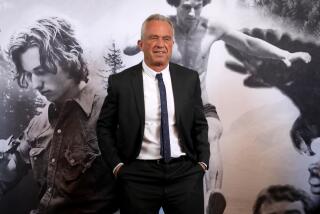The New Face of Mexican Election Coverage : With Televisa’s Broadcast Monopoly Broken, the Nation’s First TV Race Is Taking Shape
When Mexico’s publishers and editors gathered last month to hear presentations from the nine presidential candidates, veteran news anchor Jacobo Zabludovsky was seated in a place of honor that befits the man who for two decades has been the news voice of media giant Televisa.
But that catbird seat became a hot seat when third-place candidate Cuauhtemoc Cardenas rose to speak. Looking directly at Zabludovsky, he said: “Televisa has been one of the pillars that today hold up the authoritarian regime we suffer.” Then he promised, “If I am elected, you will have a freedom previously denied you: the freedom to criticize the president.”
A year ago, Cardenas’ attack might have been published in a few sympathetic newspapers with circulations in the five-figure range. This year, the cameras of Televisa’s upstart rival, Television Azteca, were there to beam the scene across this country on the nightly news.
A year after the government sold off its two networks, breaking Televisa’s private broadcasting monopoly, competition is changing television news coverage, especially that of politics. The 1994 presidential race is shaping up to be Mexico’s first television campaign, complete with this nation’s first television candidate.
The changes include the new network owners’ plans to use technology from their new partner--National Broadcasting Co.--to conduct exit polls on election day. Polls are expected to be extremely important in the Aug. 21 presidential election because most Mexicans suspect the government of vote fraud and distrust the official tallies.
The result is a striking example of how the administration’s free market economic policies--such as privatizing government-owned companies--are forcing social and political change as well.
Not that Televisa has abandoned its notoriously pro-government, pro-ruling party stance.
However, an ongoing study by the independent Human Rights Academy found that both major television news shows have provided increasingly balanced coverage as the campaign has progressed.
“They have improved their coverage of the various actors in the electoral process, but still do not present the various parties and presidential candidates in a balanced and objective manner,” the academy’s most recent report concluded.
No figures are available for comparisons with past elections, when opposition candidates were largely ignored by television news. However, there is a sense that Televisa’s main nightly newscast--called “24 Hours”--has been forced to expand its coverage of opposition candidates as Azteca has built the audience for its nightly news show from insignificant to about one-third the viewership of the veteran news broadcast.
Ironically, while Televisa executives have loosened their control over what their networks show, the overall influence of television has increased.
“Television is the medium for winning elections, but it takes a candidate who has a message and knows how to transmit it,” said Ricardo Salinas, chairman of Television Azteca.
The first televised presidential candidates’ debate last month catapulted Diego Fernandez de Cevallos from a distant third place to a solid second and even first place in some polls.
Fernandez surprised viewers with his sharp attacks on the government and his top two rivals, turning around the rather stodgy image of his National Action Party (PAN). He was the clear winner of the debate. His ratings in the polls soared and remain above 30% in many surveys, significant in a nine-candidate race.
Now, the gray-bearded Fernandez frequently appears in the featured spot on the nightly news. About 43% of those questioned in a recent survey by MORI de Mexico (with a 4.5% margin of error) said they knew Fernandez appeared on a weekly Television Azteca interview show. Of those, nearly half said they liked what he said. That’s quite a change from the last presidential campaign six years ago when PAN activists distributed bumper stickers that read: “Don’t watch Televisa. They lie.”
Fernando Alcala, who runs Televisa’s international news operation, minimizes the effect of Television Azteca on his company’s coverage, but acknowledges: “We have to be more careful with our coverage, with our images and editing. Competition has forced us to be more professional.”
Televisa has also added a youth-oriented news show on a less popular networks.
Longtime television observers, such as Raul Trejo, say competition, along with increased pressure from viewers, has had more of an impact than Alcala admits. Televisa has been forced to provide wider coverage that includes more opposition parties, he said.
Nearly every campaign--some for candidates barely expected to eke out the 1.5% of the vote their parties need to maintain their registration--receives a few minutes of coverage each night on “24 Hours.”
Even Cardenas, who complains loudest about poor TV coverage, has begun to get sound bites on the air, instead of just an announcer’s voice summarizing his speeches.
The MORI survey showed that more than half of those questioned had heard the voices of the three leading presidential candidates on the air.
Cardenas and Fernandez received long news spots when they drew large crowds at the Mexican National Autonomous University, the campus in the south of the city.
Salinas also says that he is not looking over his shoulder at the competition.
“I just have as my goal to create the best news operation in the world,” he said.
However, many of his shows’ goals are clearly directed at Televisa’s often ponderous style. “We try to have less announcers telling and more showing with images telling the story,” he said. “We try to give the news at a faster pace, but at the same time more relaxed without so much political and intellectual jargon that no one understands.”
Salinas also plans a more active role for his network’s coverage. Instead of just transmitting news, he plans to actively seek it. The exit polls using NBC technology would be an start.
Longtime television observers warn not to expect drastic changes. Despite the privatization of the networks, the air waves are still government concessions and subject to control.
Despite the fierce competition in Mexican radio, for example, news and commentary shows still have clear limits, with government censors present during live broadcasts, according to many announcers. Radio personalities who step over the line are promptly removed, usually because authorities or station owners find a technical irregularity in a license or contract.
That makes broadcast stations different from the other nearly 1,000 government companies privatized over the past decade. Those companies could come to have important roles in changing this nation as their new owners begin making decisions based on different criteria than the government would have used.
Many such companies have already initiated layoffs and plant shutdowns, but the long-term effects of those changes will probably be more subtle than the differences that television viewers see on their screens every night as private television networks compete to keep their interest.
More to Read
Start your day right
Sign up for Essential California for news, features and recommendations from the L.A. Times and beyond in your inbox six days a week.
You may occasionally receive promotional content from the Los Angeles Times.






